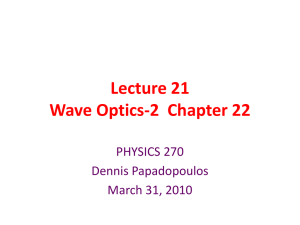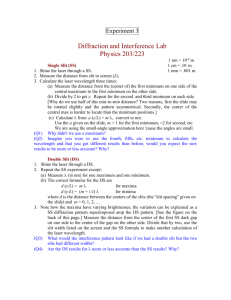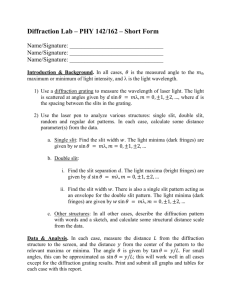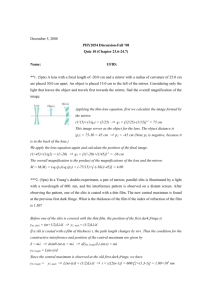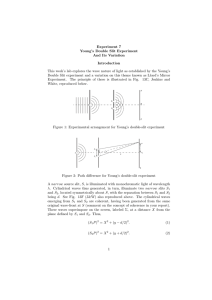hw 21
advertisement
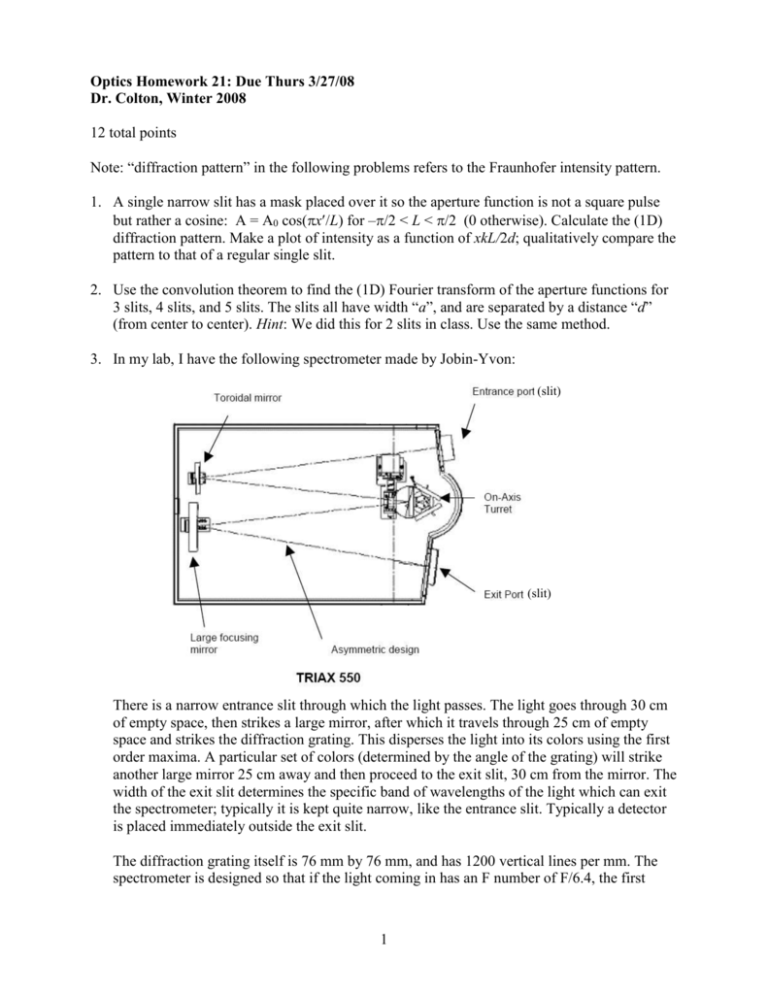
Optics Homework 21: Due Thurs 3/27/08 Dr. Colton, Winter 2008 12 total points Note: “diffraction pattern” in the following problems refers to the Fraunhofer intensity pattern. 1. A single narrow slit has a mask placed over it so the aperture function is not a square pulse but rather a cosine: A = A0 cos(x/L) for –/2 < L < /2 (0 otherwise). Calculate the (1D) diffraction pattern. Make a plot of intensity as a function of xkL/2d; qualitatively compare the pattern to that of a regular single slit. 2. Use the convolution theorem to find the (1D) Fourier transform of the aperture functions for 3 slits, 4 slits, and 5 slits. The slits all have width “a”, and are separated by a distance “d” (from center to center). Hint: We did this for 2 slits in class. Use the same method. 3. In my lab, I have the following spectrometer made by Jobin-Yvon: (slit) (slit) There is a narrow entrance slit through which the light passes. The light goes through 30 cm of empty space, then strikes a large mirror, after which it travels through 25 cm of empty space and strikes the diffraction grating. This disperses the light into its colors using the first order maxima. A particular set of colors (determined by the angle of the grating) will strike another large mirror 25 cm away and then proceed to the exit slit, 30 cm from the mirror. The width of the exit slit determines the specific band of wavelengths of the light which can exit the spectrometer; typically it is kept quite narrow, like the entrance slit. Typically a detector is placed immediately outside the exit slit. The diffraction grating itself is 76 mm by 76 mm, and has 1200 vertical lines per mm. The spectrometer is designed so that if the light coming in has an F number of F/6.4, the first 1 mirror will be completely illuminated.* The light cone is not shown in the figure, by the way—the figure incorrectly shows the light as straight lines. (a) If you send a beam of light towards the spectrometer with a light cone that converges on the entrance slit with the given F number, what is the angle of the light cone? (I’m talking about the angle in the plane of the diagram, not the solid angle.) (b) Under the circumstances of part (a), how wide should the first mirror be so that all of your light hits the mirror? (The minimum width, I mean—obviously if you make it 15 m wide, all the light will hit the mirror…) (c) Under the circumstances of part (a), suppose you are trying to analyze the details of a light spectrum around 500 nm. How close of wavelengths can you resolve? (I.e. how many nanometers apart.) (d) Assuming the second mirror is flat,† how close physically would the peaks from two wavelengths that are 1 nm apart be at the exit port? This is an important number, because it tells you how narrow your exit slit must be in order to resolve the two wavelengths. If your slit is wider than this, both peaks will come through to your detector at the same time and you won’t be able to resolve them. And the first mirror is designed so that if it’s completely illuminated, the light coming from it will completely illuminate the grating. † By comparing my answer to this part of the problem with the specification for this quantity given on the JobinYvon website, I could tell that the mirror really is close to flat, despite it being labeled a “focusing mirror”. * 2

